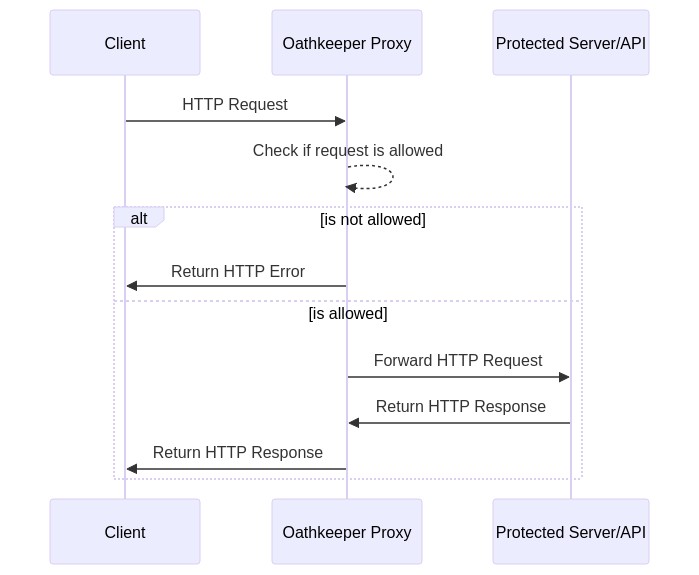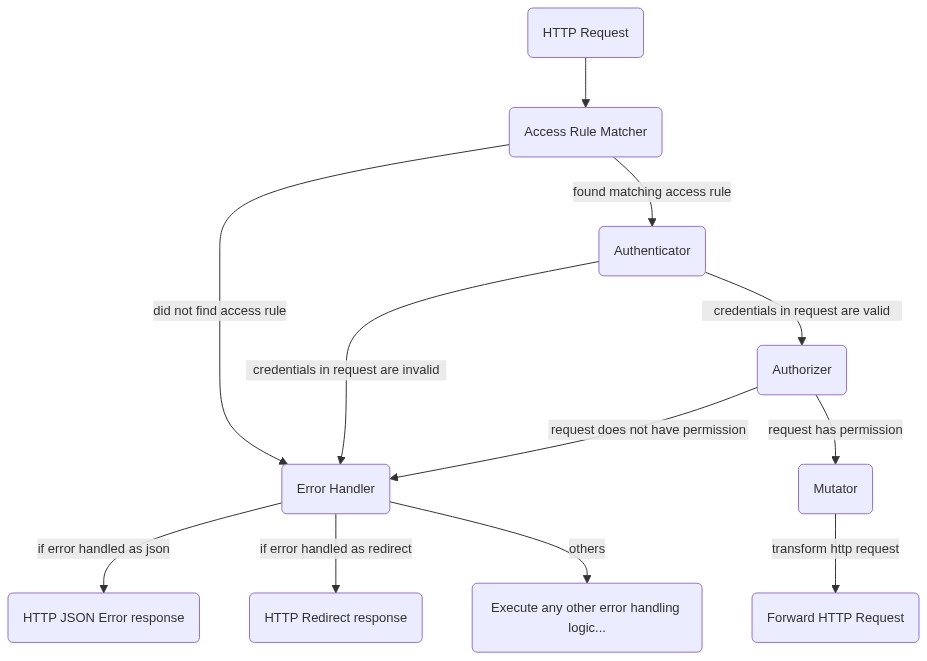Introduction to Ory Oathkeeper Zero Trust Proxy
Ory offers support for self-hosted Ory software through the Ory Enterprise License (OEL). Read more about the OEL here.
Ory Oathkeeper authorizes incoming HTTP requests. It can be the Policy Enforcement Point in your cloud architecture, i.e. a reverse proxy in front of your upstream API or web server that rejects unauthorized requests and forwards authorized ones to your server. If you want to use another API Gateway (Kong, Nginx, Envoy, AWS API Gateway, ...), Oathkeeper can also plug into that and act as its Policy Decision Point.
The implemented problem domain and scope is called Zero-Trust Network Architecture, BeyondCorp, and Identity And Access Proxy (IAP).
While Ory Oathkeeper works well with Ory OAuth2 & OpenID Connect (Ory Hydra) and Ory Keto, Ory Oathkeeper can be used standalone and alongside other stacks with adjacent problem domains (Keycloak, Gluu, Vault). Ory Oathkeeper's Access Control Decision API works with
- Emissary-ingress via auth service
- Envoy via the External Authorization HTTP Filter
- AWS API Gateway via Custom Authorizers
- Nginx via Authentication Based on Subrequest Result
among others.
Dependencies
Ory Oathkeeper doesn't have any dependencies to other services. It can work in isolation and doesn't require a database or any other type of persistent storage. Ory Oathkeeper is configurable with yaml configuration files, JSON files, and environment variables.
Operating modes
Starting Oathkeeper via oathkeeper serve exposes two ports: One port serves the reverse proxy, the other Ory Oathkeeper's API.
Reverse proxy
The port exposing the reverse proxy forwards requests to the upstream server, defined in the rule, if the request is allowed. If the request isn't allowed, Ory Oathkeeper doesn't forward the request and instead returns an error message.
Reverse proxy example
Assuming the following request
GET /my-service/whatever HTTP/1.1
Host: oathkeeper-proxy:4455
Authorization: bearer some-token
and you have the following rule defined (which allows this request)
{
"id": "some-id",
"upstream": {
"url": "http://my-backend-service"
},
"match": {
"url": "http://oathkeeper-proxy:4455/my-service/whatever",
"methods": ["GET"]
},
"authenticators": [
{
"handler": "anonymous"
}
],
"authorizer": {
"handler": "allow"
},
"mutators": [
{
"handler": "noop"
}
]
}
then the request will be forwarded by Ory Oathkeeper as follows:
GET /my-service/whatever HTTP/1.1
Host: my-backend-service:4455
Authorization: bearer some-token
The response of this request will then be sent to the client that made the request to Ory Oathkeeper.
Access Control Decision API
The Ory Oathkeeper Access Control Decision API follows best-practices and works with most (if not all) modern API gateways and
reverse proxies. To verify a request, send it to the decisions endpoint located at the Ory Oathkeeper API port. It matches every
sub-path and HTTP Method:
GET /decisions/v1/apiPUT /decisions/my/other/apiDELETE /decisions/users?foo=?bar
When matching a rule, the /decisions prefix is stripped from the matching path.
Access Control Decision API example
Assuming you are making the following request to Ory Oathkeeper's Access Control Decision API
GET /decisions/my-service/whatever HTTP/1.1
Host: oathkeeper-api:4456
Authorization: bearer some-token
and you have the following rule defined (which allows this request)
{
"id": "some-id",
"match": {
"url": "http://oathkeeper-api:4456/my-service/whatever",
"methods": ["GET"]
},
"authenticators": [
{
"handler": "noop"
}
],
"authorizer": {
"handler": "allow"
},
"mutators": [
{
"handler": "noop"
}
]
}
then this endpoint will directly respond with HTTP Status Code 200:
HTTP/1.1 200 OK
Authorization: bearer some-token
If any other status code is returned, the request must not be allowed, for example:
HTTP/1.1 401 OK
Content-Length: 0
Connection: Closed
It's also possible to have this endpoint return other error responses such as the HTTP Status Found (HTTP Status Code 302),
depending configured on the error handling. Use this feature only if your Reverse Proxy supports these type of responses.
Depending on the mutator defined by the access rule, the HTTP Response might contain additional or mutated HTTP Headers:
HTTP/1.1 200 OK
X-User-ID: john.doe
Decision engine
The decision engine allows to configure how Ory Oathkeeper authorizes HTTP requests. Authorization happens in four steps, each of which can be configured:
- Access Rule Matching: Verifies that the HTTP method, path, scheme, and host of the incoming HTTP request conform to your
access rules. The information is taken either from the URL, or from the
X-Forwarded-Method,X-Forwarded-Proto,X-Forwarded-Host,X-Forwarded-Uriheaders (if present) of the incoming request. The request is denied if no access rules match. The configuration of the matching access rule becomes the input for the next steps. - Authentication: Oathkeeper can validate credentials via a variety of methods like Bearer Token, Basic Authorization, or cookie. Invalid credentials result in denial of the request. The "internal" session state (such as the user ID) of valid (authenticated) credentials becomes input for the next steps.
- Authorization: Access Rules can check permissions. To secure, for example, an API that requires admin privileges, configure the authorizer to check if the user ID from step 2 has the "admin" permission or role. Oathkeeper supports a variety of authorizers. Failed authorization (for example user doesn't have role "admin") results denial of the request.
- Mutation: The Access Rule can add session data to the HTTP request that it forwards to the upstream API. For example, the
mutator could add
X-User-ID: the-user-idto the HTTP headers or generate a JWT with session information and set it asAuthorization: Bearer the.jwt.token.
Additionally, error handling can be configured. You may want to send an application/json response for API clients and a HTTP
Redirect response for browsers with an end user.


